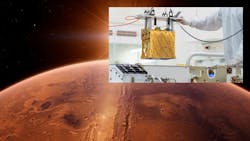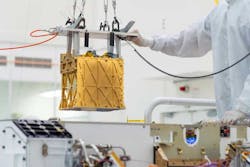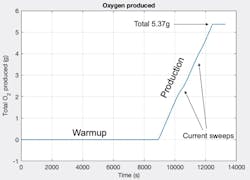NASA recently tested its “Mars oxygen in-situ resource utilization experiment” (aka Moxie) on board the Perseverance Mars rover. This toaster-sized device converts the CO2-rich Martian atmosphere into oxygen, as well as carbon dioxide as a waste product.
Moxie heats the incoming atmosphere to about 1,470°F (800°C) to carry out the extraction. This means it had to be made of heat-resistant materials, such as 3D-printed nickel alloy parts, which heat and cool the gases flowing through them. It also has a layer of a lightweight aerogel for insulation to retain the heat inside the device. A thin gold coating on Moxie’s surface reflects infrared heat, keeping it from radiating outward and potentially damaging other parts of Perseverance.
In its first test, Moxie created about five grams of oxygen, enough to keep an astronaut alive for about 10 minutes. Moxie will undergo eight more tests which fall into three phases. The first-phase tests will check out and characterize Moxie’s performance; the second phase looks at its performance in varying atmospheric conditions, such as different times of day and seasons; and in the third-phase tests, NASA will push the envelope and try new operating modes and scenarios, such comparing operations at three or more different temperatures. By the end of the testing, NASA expects Moxie will demonstrate its targeted production rate of extracting 10 grams of oxygen per hour.
If Moxie meets NASA expectations, the technology it is based on could be used to supply future Mars explorers with oxygen to breathe and with a major proponent of the rocket fuel they will need to return to Earth.
To burn fuel, the returning rocket must have more oxygen by weight. Getting four astronauts off the Martian surface and to an orbiting return spaceship, for example, would require approximately 15,000 lb of rocket fuel and 55,000 lb of oxygen. In comparison, the four astronauts living and working on Mars would require just 2,200 lb of oxygen to breathe.
The alternative to using Moxie-type technology to get oxygen on Mars would be to carry about 60,000 lb of it on the trip from Earth to Mars. It would be more efficient and less costly to carry a 2,000-lb Moxie-based O2 extractor that could supply that same oxygen.


